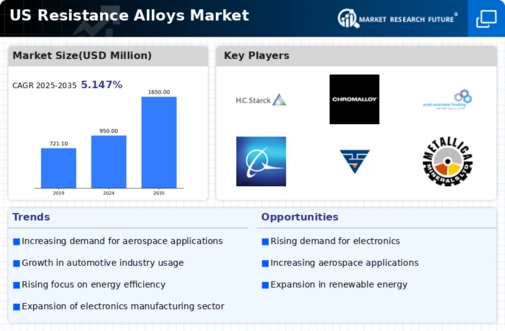The resistance alloys market is characterized by a competitive landscape that is increasingly shaped by innovation, strategic partnerships, and a focus on sustainability. Key players such as Special Metals Corporation (US), Haynes International Inc. (US), and Carpenter Technology Corporation (US) are actively pursuing strategies that enhance their market positioning. Special Metals Corporation (US) emphasizes innovation in product development, particularly in high-performance alloys, which positions it favorably against competitors. Meanwhile, Haynes International Inc. (US) focuses on expanding its global footprint through strategic partnerships, thereby enhancing its supply chain capabilities and market reach. Carpenter Technology Corporation (US) is also notable for its commitment to sustainability, integrating eco-friendly practices into its operations, which resonates well with current market demands.
The business tactics employed by these companies reflect a concerted effort to optimize supply chains and localize manufacturing processes. The market structure appears moderately fragmented, with several players vying for market share. However, the collective influence of these key players is significant, as they drive innovation and set industry standards. Their strategies not only enhance their competitive edge but also contribute to shaping the overall market dynamics.
In November 2025, Special Metals Corporation (US) announced a new line of high-temperature alloys designed for aerospace applications. This strategic move is likely to bolster its position in the aerospace sector, which is increasingly demanding materials that can withstand extreme conditions. The introduction of these alloys may enhance the company's reputation for innovation and quality, potentially attracting new clients in the aerospace industry.
In October 2025, Haynes International Inc. (US) entered into a strategic partnership with a leading aerospace manufacturer to develop advanced materials for next-generation aircraft. This collaboration is expected to leverage both companies' strengths, facilitating the development of innovative solutions that meet the evolving needs of the aerospace sector. Such partnerships are indicative of a broader trend towards collaboration in the industry, aimed at accelerating product development and enhancing competitive positioning.
In September 2025, Carpenter Technology Corporation (US) launched a sustainability initiative aimed at reducing its carbon footprint by 30% by 2030. This initiative not only aligns with global sustainability goals but also positions the company as a leader in eco-friendly practices within the resistance alloys market. The emphasis on sustainability is becoming increasingly important, as customers and regulators alike prioritize environmentally responsible practices.
As of December 2025, the competitive trends in the resistance alloys market are heavily influenced by digitalization, sustainability, and the integration of AI technologies. Strategic alliances are becoming more prevalent, as companies recognize the need to collaborate to stay competitive. The shift from price-based competition to a focus on innovation, technology, and supply chain reliability is evident. Moving forward, companies that can effectively differentiate themselves through these avenues are likely to thrive in an increasingly complex market.






















Leave a Comment